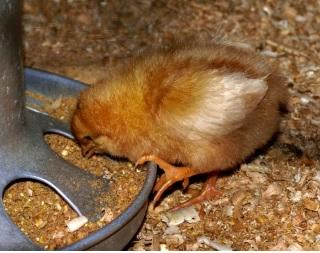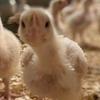Non-Infectious Leg Health Issues of Poultry
Published: November 3, 2021
By: Hailee Yoder, Purdue University; Dr. Marisa Erasmus, Purdue University. Reviewers: Dr. Leonie Jacobs, Virginia Tech; Dr. Prafulla Regmi, North Carolina State University; Dr. Shawna Weimer, University of Maryland.

Leg problems are among the top health concerns of poultry raised for meat. Leg problems influence poultry at all stages of production, lead to reduced productivity and contribute to mortality. Leg problems have many different causes and contributing factors, including infectious causes, growth rate and weight gain, diet, lighting program, light intensity, stocking density (space available per animal), litter quality, type of bedding and bird activity level and exercise.
A variety of leg health issues occur in commercial poultry. Some of the most common leg problems include Footpad Dermatitis (FPD), long bone distortion, Tibial Dyschondroplasia (TD); all of these conditions can lead to lameness, but lameness may have other causes as well.

COMMON NON-INFECTIOUS LEG ISSUES
Footpad dermatitis - FPD is a combination of inflammation and lesions on the footpad. FPD can lead to open wounds that can further lead to infections and can reduce the birds' ability to walk and reach feed and water. See PEC newsletter vol. 9 for more information.
Long Bone Distortion - Long Bone Distortion is an overarching term that includes various conditions such as bowed legs, knock knees, and twisted legs, among others. Long Bone Distortion typically occurs at higher rates in males.
Tibial dyschondroplasia - TD is a skeletal abnormality associated with abnormal cartilage growth. TD is typically associated with rapid weight gain in poultry and leads to mobility issues.
Lameness - Lameness or leg weakness influences the bird's ability to walk and may be associated with pain. Birds that are unable to walk properly are less active, rest more and may develop other conditions such as hock burn and breast blisters.
In addition to the aforementioned leg health issues, there are various infectious causes of leg problems, such as bacterial chondronecrosis with osteomyelitis(BCO) and viral arthritis, but these will not be discussed here.
RISK FACTORS
- Humidity. Humidity can present problems in the rates of leg health issues occurring. Higher humidity levels can result in more leg issues. It is important to ensure that humidity levels in the housing areas are not too high. High humidity can influence the quality of the bedding and litter that birds rest and walk on.
- Bedding type. When selecting a bedding substrate, the most important quality is how well it can absorb moisture and release moisture and ammonia quickly. The moisture level of the litter should remain under 30%.
- Space per bird. Crowding poultry can lead to higher risks of leg health issues and increase the labor associated with maintaining good litter quality and good air quality.
PREVENTION AND MITIGATION STRATEGIES
There are a number of factors that are believed to help reduce the occurrence of leg issues in poultry. Some things that can be adjusted in order to reduce the incidences of leg problems are lighting, diet, and environmental factors.
Lighting
Poultry naturally have a circadian rhythm that controls their sleep-wake cycle. Like many other animals, poultry are active during the light hours and adjust their behavior and activity levels to their environment and photoperiod. Lighting can influence poultry leg health in several ways: not providing poultry with a period of darkness within 24 hours can lead to higher risks of leg problems and reduced walking ability. The suggested darkness period is 6-8 hours for best results(see PEC newsletter Vol.10). The intensity of light provided can possibly influence poultry leg health. Brighter light leads to higher activity levels and more exercise, which could lead to improved leg health.

Diet
Ensuring that poultry receives appropriate and adequate nutrients for their age, stage of production and genetic strain is key to poultry health. Rapid weight gain is one factor that increases the risk of leg health issues of poultry. Deficiencies of certain nutrients, vitamins and minerals, such as vitamin D, calcium and phosphorus lead to leg problems. For broiler chickens, there is evidence to suggest that feeding whole wheat in the diet can improve walking ability.
For fast growing birds, restricting the amount of time that birds have food available can help reduce leg health problems. There are various dietary supplements available that can possibly influence leg and skeletal health and these supplements should be used in consultation with poultry nutrition experts.
Environmental factors
In addition to paying attention to litter type and factors that influence litter moisture, appropriate environmental enrichment (see PEC newsletter vol. 5)can help to increase activity levels of poultry and potentially reduce leg health problems(further research is needed to establish the link between leg health and enrichment).
In conclusion, management is key
- Although rapid growth rates and selection of poultry for higher feed efficiency lead to higher risks of leg health issues, there are many factors that influence the development of leg health issues in poultry.
- To ensure poultry health and welfare, it is important to check birds daily and monitor them for signs of injury and changes in their walking ability. If you begin to see issues related to walking, evaluate your management practices to see what changes (such as litter management, humane culling and environmental changes)could be made to potentially alleviate the problem.
- Attention to litter quality, air quality and nutrition can go a long way in ensuring that birds are healthy.
- Providing birds with an environment that meets their needs at all stages of production can help ensure bird health and productivity.
This article was originally published on Poultry Extension Collaborative (PEC) and it is reproduced here with permission from the authors.
- Bassler, A.W., Arnould, C., Butterworth, A., Colin, L., De Jong, I.C., Ferrante, V., Ferrari, P.Haslam, S., Wemelsfelder, S.& H.J. Blokhuis. 2013. Potential risk factors associated with contact dermatitis, lameness, negative emotional state, and fear of humans in broiler chicken flocks. Poultry Science. 92: 2811-2826.
- Erasmus, M. A. (2018) Chapter13 Welfare issues in turkey production. In: Advances in poultry welfare. Mench, J. A. (ed.). Woodhead Publishing, Cambridge, MA.
- Gocsik, É., Silvera, A. M.,Hansson,H., Saatkamp,H. W.&H. J. Blokhuis(2017) Exploring the economic potential of reducing broiler lameness, British Poultry Science, 58: 337-347, DOI:10.1080/00071668.2017.1304530.
- Hester, P. Y. (1994). The Role of Environment and Management on Leg Abnormalitiesin Meat-Type Fowl. Poultry Science, 73: 904-915. doi:10.3382/ps.0730904.
- Hester, P. Y., Sutton, A. L.,&Elkin, R. G. (1987). Effect of Light Intensity, Litter Source, and Litter Management on the Incidence of Leg Abnormalities and Performance of Male Turkeys. Poultry Science, 66: 666-675. doi:10.3382/ps.0660666.
- Hocking, P.,& Wu, K. (2013). Traditional and commercial turkeys show similar susceptibility to foot pad dermatitis and behavioural evidence of pain. British Poultry Science,1-8. doi:10.1080/00071668.2013.781265.
- Julian, R. J. (2005). Production and growth-related disorders and other metabolic diseases of poultry – A review. The Veterinary Journal,169: 350-369. doi:10.1016/j.tvjl.2004.04.015.
- Knowles TG, Kestin SC, Haslam SM, Brown SN, Green LE, et al (2008) Leg Disorders in Broiler Chickens: Prevalence, Risk Factors and Prevention. PLoS ONE 3(2): e1545. doi:10.1371/journal.pone.0001545.
- Waldenstedt, L. (2006) Nutritional factors of importance for optimal leg health in broilers: a review. Animal Feed Science and Technology,126: 291-307.
Related topics:
Authors:




Show more
Recommend
Comment
Share
21 de noviembre de 2021
After Mycoplasma Synovie infection, lameness has been observed in Poultry also.
Recommend
Reply

Would you like to discuss another topic? Create a new post to engage with experts in the community.










